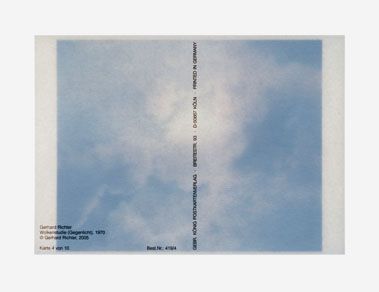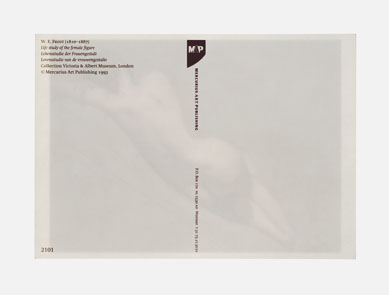Claudia Angelmaier
Friday, 10 July 2009
Work from Works on Paper.
I encountered Angelmaier’s work the other day at Galerie Alexandra Saheb, this work is (as I am sure has been said) strongly remiscent of Robert Heinecken’s Recto / Verso. Now, this is a very basic and aesthetic observation, as I think the conceptual concerns are different, albeit with several fundamental similarities. In an examination of advertising and context, one is compelled to consider the implications of canonized masterpieces of art, their existence as a museum card, and how the transparency of context, both literal and figurative, challenge and obsurce the actual work.
Galeria Kleindienst also has a good selection of her work.
“Claudia Angelmaier’s works quote the great masterpieces of art and their history. She approaches pictures in the form of reproductions that she finds in books, postcards or slides. These then become the material of her works. Hence, the motif is no longer the “original”, but the photographic reproduction that also leads to the work’s familiarity. Angelmaier’s photographs address the question of our viewing habits in a world flooded with visual media.
In the series “Works on Paper”, Angelmaier works with various art postcards that share the themes of the Rückenfigur (a figure seen from the back) and the Romantic landscape. She photographs the postcards in such a way that, although they are seen from the back, the viewer is also confronted with the front – the picture side. The art postcard acts as a souvenir, a memory of the artwork; its mass circulation contributes to the work’s popularisation. Angelmaier’s works elevate the art postcard to the status of a tableau. The just visible image on the front – the reproduction of the artwork – is given back its original dimensions. Nevertheless, the contemplative viewing of the picture is disturbed by the way in which it has been photographed. The viewer is confronted with the normal details of postcards such as the barcode or fine dividing lines and the printed text of the card. The latter provides the meta-level of the picture: the work’s title, author, size, location, medium etc. By showing and making us conscious of what is “behind” the picture – the classification as object within the art market or the art historical system – the postcard is implicitly changed from being a collectors’ item back into an object of communication.
The artist carries out a double game. By giving the work back its “original” dimensions, she brings us closer to this work; however, the further reproduction – now reversed and partially overlapped – of the work becomes a shadow of itself. This results in a constant oscillation between visibility and disappearance, illusion and pictorial reality – something is revealed and simultaneously hidden.” – Galeria Alexandra Saheb




